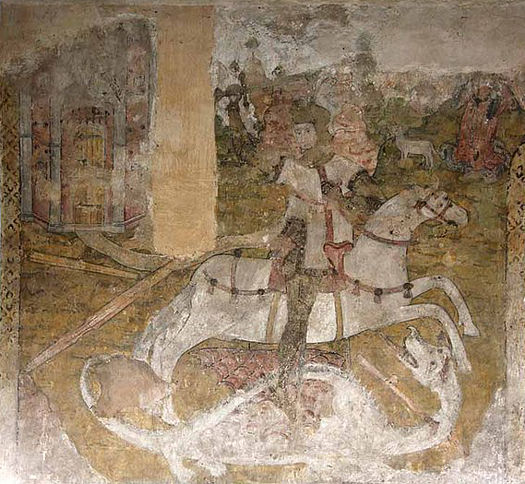Fritton, Norfolk (Norwich) C.15
St George and the Dragon

A very spirited St George, damaged in one area (by removal of a roof-beam, probably), but with saint, horse and impressive Dragon very well rendered. There are good background details too; at the top left is a palace or city gate, perhaps featuring a portcullis, with a roadway curving away from it.
Although the upper part of the painting is now rather murky, on close scrutiny further details reveal themselves. In the background above the horse’s head is the symbolic lamb that features in other paintings of St George’s story, notably that at Broughton in Buckinghamshire, where its likely significance is discussed. Here it stands facing left, hard to see but detectable.
Since the lamb is here, then almost certainly the princess is also, and what is left of her figure is probably the dark area of reddish pigment to the right of the lamb. The folds of her robe, visible under greater magnification than is possible here, suggest that she is kneeling, a posture mirrored in the Broughton example and consistent with the story of her rescue. Another indistinct detail is St George’s right arm, which is extended above and to the left beside the damaged area. In his right hand he holds the short sword with which he is about to deal the death-stroke. A patch of creamy-orange pigment suggesting something sitting on his left shoulder is, I think, simply surface damage rather than some meaningful detail.
Also at Fritton is a very faded and obscure St Christopher, with a watercolour of it made in the 1860s and showing a considerable amount of background detail now lost, and the remains of a painting of a unidentifiable bishop in full regalia. There is also a good 15th century screen with apostles, including a particularly fine St Simon holding his emblem, a prodigiously large fish.
Website for St Catherine’s, Fritton
(NB: there are two villages called Fritton in Norfolk – this is inland to the south and east, near Tacolneston and Shelton)